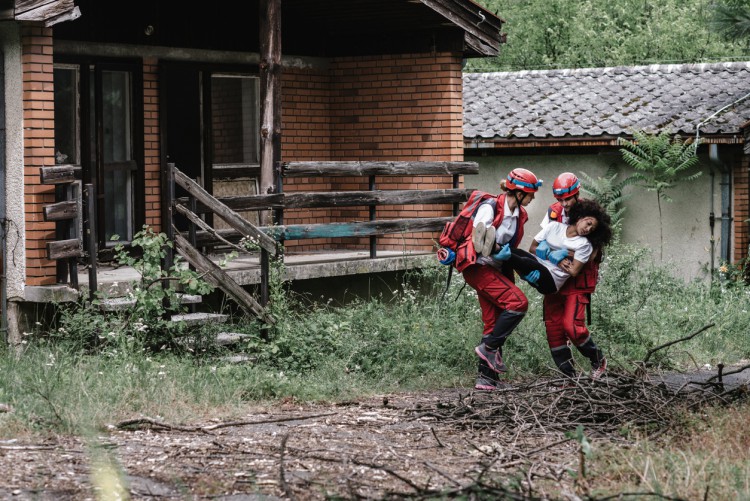How to Become a Disaster Relief Worker: A Crucial Career in KindnessHow to Become a Disaster Relief Worker: A Crucial Career in KindnessHow to Become a Disaster Relief Worker: A Crucial Career in Kindness
Recovery in the aftermath of a disaster can feel nearly impossible. Questions about medical aid, shelter, and the well-being of loved ones can overwhelm even the staunchest survivors, to the point where moving forward may require help. Fortunately, disaster relief workers can step in and provide aid and guidance to those who’ve had their lives upended. It’s a satisfying career for those with a heart for helping others. For people interested in pursuing the role in a professional capacity, it’s important to learn how to become a disaster relief worker.
What Does a Disaster Relief Worker Do?
A disaster relief worker’s role is to provide aid in the wake of a disaster so survivors can return to a sense of normalcy. Disaster relief workers’ responsibilities are divided into four key phases: preparedness, response, recovery, and mitigation. In the preparedness phase, they’re charged with developing emergency response strategies for different scenarios. When disaster does strike, they enter the response phase, helping to execute plans through logistics coordination and neighborhood evaluation. They work to rescue people in the affected area, preserve property, and give humanitarian aid.
In the recovery phase, disaster relief workers play a key role in helping people address their health, economic, and social service needs. In the mitigation phase, they analyze the aftermath of the disaster and develop strategies to minimize the potential for damage of future similar disasters. Their work beyond the response phase is the primary difference that separates them from volunteers.
Disaster relief workers can work with nonprofit or government agencies, such as the Federal Emergency Management Agency (FEMA) and the U.S. Department of Homeland Security (DHS).

Steps to Become a Disaster Relief Worker
While their primary goal is benevolent, disaster relief workers must have more than a desire to help to succeed. Numerous steps are required to move from volunteer to professional.
The Skills of a Disaster Relief Worker
No two disasters are alike. Even the slightest difference in two earthquakes hitting the same region will cause differences in response and recovery. Because of this, successful disaster relief workers must have advanced critical thinking and decision-making skills. They must also have strong communication competencies, as they may be required to give vital orders in recovery operations. Additionally, they must have well-developed interpersonal skills to properly interact with those in need.
Educational and Certification Requirements
Typically, the base educational requirement to pursue a disaster relief worker position is a bachelor’s degree. Earning one such as Maryville University’s Bachelor of Arts in International Studies can help students gain the knowledge needed to understand and to act upon the four key phases of disaster relief. Its curriculum can also help students cultivate the core competencies at a level needed to succeed, which can enable them to enter the profession with a greater sense of confidence.
Another crucial element regarding how to become a disaster relief worker is certification. Some states require certification for advanced disaster relief worker roles, such as emergency management directors. These requirements may apply after an individual gets hired and must be obtained in a certain time frame. Those who pursue the profession with the goal of advancing should confirm the requirements for the states in which they plan to do work.
The Salary of a Disaster Relief Worker
According to November 2019 data from PayScale, the median annual salary for disaster relief workers is around $60,000. The precise figure depends on factors including experience, education level, and regional cost of living.
Learn More About Becoming a Disaster Relief Worker
Disaster relief workers do more than help communities recover from natural and human-made disasters; they help to restore a sense of normalcy, which can play a vital role in recovery. Learn how Maryville University’s online Bachelor of Arts in International Studies program and its detailed study into subjects such as global culture, economics, history, and politics can help individuals develop the knowledge and skills needed to pursue this satisfying, crucial career.
Recommended Reading
Disaster Preparedness: Nurses on the Front Line
Making an Impact by Volunteering Abroad
Sources
American Red Cross, Disaster Relief
Habitat for Humanity, Disaster Response
Houston Chronicle, Job Assistance for Disaster Assistance Employees
Maryville University, Bachelor of Arts in International Studies
National Association of Social Workers California Chapter, Volunteering for the Red Cross
PayScale, Salary for Industry: Disaster Relief Services
U.S. Bureau of Labor Statistics, Careers in Disaster Relief
U.S. Bureau of Labor Statistics, Emergency Management Directors
Be Brave
Bring us your ambition and we’ll guide you along a personalized path to a quality education that’s designed to change your life.

